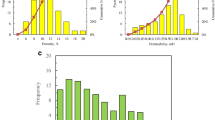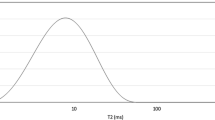Abstract
The main purpose of comprehensive reservoir characterization is to reliably calculate, characterize and identify petrophysical parameters including porosity, permeability, rock fabrics, pore size distribution, pore network system, saturation and capillary pressure. These essential petrophysical properties could be achieved by a combination of Nuclear Magnetic Resonance (NMR), conventional and special core analysis (CCAL/SCAL) in core laboratories. In this study, six core plug samples from the Asmari carbonate Formation in Gachsaran oilfield have been examined by the core measurements and NMR technique to evaluate and compare the petrophysical properties. Initially, the plug samples are prepared by core plugging, trimming, solvent cleaning and oven drying methods. Comparison between well Gamma ray log and core gamma ray adjust the depth to the real position of reservoir target. Basic SCAL measurements are then conducted on the prepared plugs in steps to calculate porosity, permeability, capillary pressure and fluid movements. Then the dry samples are completely saturated with brine and the basic properties are re-measured by the NMR method. The relationship between rock quality values (porosity and permeability) determined from NMR technique and core results demonstrate that by applying some adjustments on NMR modeled values, the precise results are achievable. Pore size distribution curves displayed in this paper confirm the NMR modeled pore throat curves and shows NMR could be applied as useful technique for estimating pore size distribution when they are in agreement with Mercury Injection Capillary Pressure (MICP) pore size distribution. The NMR pseudo capillary pressure curves show consistency with capillary pressure and saturation behavior of MICP tests. In addition, the lithology, rock fabric and pore shapes are checked by petrographic images of thin sections as representative of microscopic reservoir characteristics in the reservoir. In present study, applying of NMR technique to the plugs and comparison the obtained results with SCAL results demonstrate how the NMR technique can objectively and quantitatively provide petrophysical analysis for a carbonate reservoir and combination of core analysis and NMR technique could optimize reservoir quality investigation.















Similar content being viewed by others
Change history
29 November 2022
A Correction to this paper has been published: https://doi.org/10.1007/s13146-022-00833-x
References
Akkurt R, Cherry R (2001) The key to improving the vertical resolution of multi-frequency NMR logging tools. In: SPWLA 42nd Annual Logging Symposium. Society of petrophysicists and well-log analysts
Alavi M, Mahdavi MA (1994) Stratigraphy and structures of the Nahavand region in western Iran, and their implications for the Zagros tectonics. Geol Mag 131(1):43–47
Altunbay M, Martain R, Robinson M (2001) Capillary pressure data from NMR logs and its implications on field economics. In: SPE annual technical conference and exhibition. Society of Petroleum Engineers
Amabeoku MO, Funk JJ, Al-Dossary SM, Al-Ali HA (2001) Calibration of permeability derived from NMR logs in carbonate reservoirs. In: SPE Middle East Oil Show. Society of Petroleum Engineers
Benavides F, Leiderman R, Souza A, Carneiro G, de VasconcellosAzeredo RB (2020) Pore size distribution from NMR and image-based methods: a comparative study. J Petrol Sci Eng 184:106321
Berberian M (1995) Master “blind” thrust faults hidden under the Zagros folds: active basement tectonics and surface morphotectonics. Tectonophysics 241(3–4):193–224
Berberian M, King GCP (1981) Towards a paleogeography and tectonic evolution of Iran. Can J Earth Sci 18(2):210–265
Coates G, Denoo S (1981) The producibility answer product. Tech Rev 29(2):54–63
Daigle H, Thomas B, Rowe H, Nieto M (2014) Nuclear magnetic resonance characterization of shallow marine sediments from the Nankai Trough, Integrated Ocean Drilling Program Expedition 333. J Geophys Res Solid Earth 119(4):2631–2650
Dakhelpour-Ghoveifel J, Shegeftfard M, Dejam M (2019) Capillary-based method for rock ty** in transition zone of carbonate reservoirs. J Petrol Explor Prod Technol 9(3):2009–2018
Dickson JAD (1965) A modified staining technique for carbonates in thin section. Nature 205(4971):587–587
Ehrenberg SN, Pickard NAH, Laursen GV, Monibi S, Mossadegh ZK, Svånå TA, Aqrawi AAM, McArthur JM, Thirlwall MF (2007) Strontium isotope stratigraphy of the Asmari formation (Oligocene-Lower Miocene), SW Iran. J Petrol Geol 30(2):107–128
Fang T, Zhang L, Liu N, Zhang L, Wang W, Yu L, Li C, Lei Y (2018) Quantitative characterization of pore structure of the Carboniferous-Permian tight sandstone gas reservoirs in eastern Linqing depression by using NMR technique. Petrol Res 3(2):110–123
Farshi M, Moussavi-Harami R, Mahboubi A, Khanehbad M, Golafshani T (2019) Reservoir rock ty** using integrating geological and petrophysical properties for the Asmari Formation in the Gachsaran oil field, Zagros basin. J Petrol Sci Eng 176:161–171
Gong Y, Liu S, Zhao M, **e H, Liu K (2016) Characterization of micro pore throat radius distribution in tight oil reservoirs by NMR and high pressure mercury injection. Pet Geol Exp 38:389–394
Hamada GM, Al-Blehed MS, Al-Awad MNJ (1999) NMR logs find reserves by-passed by conventional analysis. Oil Gas J 97(39):75–80
Hoffman RE (2006) Measurement of magnetic susceptibility and calculation of shape factor of NMR samples. J Magn Reson 178(2):237–247
Homke S, Vergés J, Garcés M, Emami H, Karpuz R (2004) Magnetostratigraphy of Miocene-Pliocene Zagros foreland deposits in the front of the Push-e Kush arc (Lurestan Province, Iran). Earth Planet Sci Lett 225(3–4):397–410
Hosseinzadeh S, Kadkhodaie A, Yarmohammadi S (2020) NMR derived capillary pressure and relative permeability curves as an aid in rock ty** of carbonate reservoirs. J Petrol Sci Eng 184:106593
Kadkhodaie A, Yarmohammadi S (2019) Carbonate microfacies study by using images processing algorithms, K-mean clustering and nearest neighbor segmented classifying: an example from the Salman Oil and Gas Field, Persian Gulf. Geopersia, Iran
Kharraa HS, Al-Amri MA, Mahmoud MA, Okasha TM (2013) Assessment of uncertainty in porosity measurements using NMR and conventional logging tools in carbonate reservoir. In: SPE Saudi Arabia Section Technical Symposium and Exhibition. Society of Petroleum Engineers.
Laursen GV, Monibi S, Allan TL, Pickard NAH, , Hosseiney A, Vincent B, Hamon Y, Van Buchem FSP, Moallemi A, Druillion G (2009) The Asmari Formation revisited: changed stratigraphic allocation and new biozonation. In: Shiraz 2009–1st EAGE International Petroleum Conference and Exhibition (pp. cp-125). European Association of Geoscientists & Engineers
Lyu C, Ning Z, Wang Q, Chen M (2018) Application of NMR T 2 to pore size distribution and movable fluid distribution in tight sandstones. Energy Fuels 32(2):1395–1405
Mao ZQ, He YD, Ren XJ (2005) An improved method of using NMR T2 distribution to evaluate pore size distribution. Chin J Geophys 48(2):412–418
Marschall D, Gardner JS, Mardon D, Coates GR (1995) Method for correlating NMR relaxometry and mercury injection data. In: 1995 SCA Conference, paper, vol 9511
Monjezi N, Amirshahkarami M, Bakhtiar HA, Shirazi MPN, Mirzaee A (2019) Palaeoecology and microfacies correlation analysis of the Oligocene-Miocene Asmari formation, in the Gachsaran oil field, Dezful Embayment, Zagros Basin, Southwest Iran. Carbonates Evaporites 34(4):1551–1568
Moradi M, Moussavi-Harami R, Mahboubi A, Khanebad M (2019) Relationship between depositional facies and reservoir characteristics of the Oligo-Miocene Asmari Formation, Aghajari Oilfield, SW Iran. Geopersia 9(1):21–41
Motiei H (1993) Stratigraphy of Zagros. Treatise Geol Iran 1:60–151
Pourmorad S, Jokar A, Jahan S (2021) Determination of key beds from the cap rocks of oil reservoirs using a novel method, Case Study: the Gachsaran formation. Southwest Iran Lithol Mineral Resour 56(6):559–578
Schlumberger (2019) Technical challenges—carbonatereservoirs. https://www.slb.com/technical-challenges/carbonates. Accessed 24 Sept 2019
Sepehr M, Cosgrove JW (2004) Structural framework of the Zagros fold–thrust belt, Iran. Mar Petrol Geol 21(7):829–843
Sherkati S, Molinaro M, de Lamotte DF, Letouzey J (2005) Detachment folding in the Central and Eastern Zagros fold-belt (Iran): salt mobility, multiple detachments and late basement control. J Struct Geol 27(9):1680–1696
Tiab D, Donaldson EC (2015) Petrophysics: theory and practice of measuring reservoir rock and fluid transport properties. Gulf professional publishing
Timur A (1968) An investigation of permeability, porosity, and residual water saturation relationships. In: SPWLA 9th annual logging symposium. Society of Petrophysicists and Well-Log Analysts.
Trevizan W, Coutinho B, Netto P, Rios E, Ramos P, Salazar J, Bressan M (2015) Magnetic resonance (NMR) approach for permeability estimation in carbonate rocks. In: OTC Brasil. Offshore Technology Conference.
Van Buchem FSP, Allan TL, Laursen GV, Lotfpour M, Moallemi A, Monibi S, Motiei H, Pickard NAH, Tahmasbi AR, Vedrenne V, Vincent B (2010) Regional stratigraphic architecture and reservoir types of the Oligo-Miocene deposits in the Dezful Embayment (Asmari and Pabdeh Formations) SW Iran. Geol Soc Lond Spec Publ 329(1):219–263
Vaziri-Moghaddam H, Kimiagari M, Taheri A (2006) Depositional environment and sequence stratigraphy of the Oligo-Miocene Asmari Formation in SW Iran. Facies 52(1):41–51
Washburn EW (1921) The dynamics of capillary flow. Phys Rev 17(3):273
Wei DF, Liu XP, Hu XX, Xu R, Zhu LL (2015) Estimation of permeability from NMR logs based on formation classification method in tight gas sands. Acta Geophys 63(5):1316–1338
Westphal H, Surholt I, Kiesl C, Thern HF, Kruspe T (2005) NMR measurements in carbonate rocks: problems and an approach to a solution. Pure Appl Geophys 162(3):549–570
**ao L, Mao ZQ, Li GR, ** Y (2012) Calculation of porosity from nuclear magnetic resonance and conventional logs in gas-bearing reservoirs. Acta Geophys 60(4):1030–1042
Yan W, Sun J, Sun Y, Golsanami N (2018) A robust NMR method to measure porosity of low porosity rocks. Microporous Mesoporous Mater 269:113–117
Yarmohammadi S, Kadkhodaie A, Hosseinzadeh S (2020) An integrated approach for heterogeneity analysis of carbonate reservoirs by using image log based porosity distributions, NMR T2 curves, velocity deviation log and petrographic studies: a case study from the South Pars gas field, Persian Gulf Basin. J Petrol Sci Eng 192:107283
Yu Y, Luo X, Wang Z, Cheng M, Lei Y, Zhang L, Yin J (2019) A new correction method for mercury injection capillary pressure (MICP) to characterize the pore structure of shale. J Nat Gas Sci Eng 68:102896
Yujiao HAN, Cancan ZHOU, Yiren F, Chaoliu L, Chao Y, Yunhai C (2018) A new permeability calculation method using nuclear magnetic resonance logging based on pore sizes: a case study of bioclastic limestone reservoirs in the A oilfield of the Mid-East. Pet Explor Dev 45(1):183–192
Acknowledgements
This study is a part of the coauthor’s dissertation at Amirkabir University of Technology, Tehran. The first and corresponding author would like to thank NIOC for their support and data.
Author information
Authors and Affiliations
Corresponding author
Additional information
Publisher's Note
Springer Nature remains neutral with regard to jurisdictional claims in published maps and institutional affiliations.
Rights and permissions
Springer Nature or its licensor (e.g. a society or other partner) holds exclusive rights to this article under a publishing agreement with the author(s) or other rightsholder(s); author self-archiving of the accepted manuscript version of this article is solely governed by the terms of such publishing agreement and applicable law.
About this article
Cite this article
Shabani, M., Yarmohammadi, S. & Ghaffary, S. Reservoir quality investigation by combination of core measured data and NMR technique analysis: a case study of Asmari carbonate reservoir in Gachsaran field. Carbonates Evaporites 38, 1 (2023). https://doi.org/10.1007/s13146-022-00824-y
Accepted:
Published:
DOI: https://doi.org/10.1007/s13146-022-00824-y




